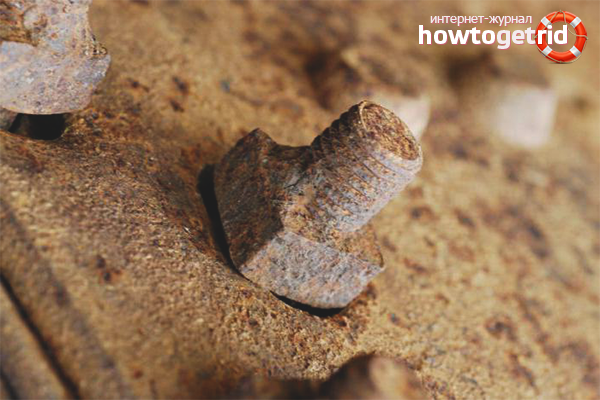The content of the article
Deadly stuck nut, this is a common problem. It is often encountered by motorists, plumbers, cyclists and locksmiths. It always takes a lot of time and effort to unscrew a rusted nut.
There are several ways that will facilitate the solution of such a difficult task. But before you apply various tricks, familiarize yourself with the reasons that lead to souring of the nut and safety precautions.
Why a rusty nut is difficult to unscrew
The main culprit for a poorly unscrewed nut is rust. This is one of the varieties of corrosion that appears on the surface of iron. The cause of such formations is the reaction of the metal with oxygen in a humid environment.
In the process of corrosion formation, a multiple increase in the oxidation product (rust) occurs. As a result, the nut and bolt tightly merge with each other. Souring of metals can be so strong that when you try to turn the nut, you can easily break the bolt.
Another culprit, a poorly loosening nut, is pollution. Small particles of metal chips and dust remain on the surface of the thread. When the nut is tightened, dirt becomes an additional obstacle. As a result, the threaded surfaces of the bolt and nut are jammed.
The third reason is tightening the nut too much. Some novice locksmiths tighten the nut almost with their feet. It takes a little time, tightly clamped metal surfaces, stick to each other, aggravating the situation. As a result, a tightened nut cannot be unscrewed.
And the last reason, failed attempts to turn the nut, is a poor-quality tool. During prolonged use, the edges of the keys are deformed or grinded. It becomes difficult for a damaged tool to grab onto the nut and tear off the thread.
Which tool is better to use
A correctly selected tool will help to quickly unscrew the rusty nut and not damage it. To successfully deal with the problem, use a set of devices. The following tools are best suited for loosening attached nuts:
- a set of heads with a head
- mechanical wrench;
- socket wrench;
- spanner keys.
Safety precautions
- Do not use a damaged tool.
- Unscrew the nut counterclockwise.
- Securely fix the tool to the nut.
- Wear gloves to avoid personal injury.
How to unscrew a rusted nut
You are making great efforts and spending a lot of time to turn the nut, but nothing comes of it. Do not be upset and torture yourself in vain. Set the instrument aside until it breaks and use a liquid that can dissolve rusty deposits and reduce friction.
There are many types of such substances, for example, the most famous tool is WD-40. There are other rust-dissolving fluids, such as kerosene, carburetor cleaner, gasoline and brake fluid. No less effective can be table vinegar, iodine and alcohol. Some locksmiths noticed a benefit even in Coca-Cola or Fant, which include inorganic phosphoric acid.
Instruction manual
- Moisten a rusted nut well and wait 15-30 minutes. After the allotted time, take a key and try to turn a nut. If this does not work, then the liquid has not penetrated deep enough. Try to wet again, but already a napkin or a strip of rags, and then wrap the nut. So the liquid lasts longer on the metal and can better dissolve rust.
- After carrying out a similar procedure, the nut will gradually begin to move. You can speed up the loosening by knocking with a hammer. Then take the key (if possible, lengthen it, for example, with a pipe segment), fix it securely on the nut and try to rip it off the thread with a very sharp jerk. If the nut is small, then it is better to unscrew the screwdriver (forward and backward).
Heating nut
Instruction:Warm the nut and bolt well (preferably red). And then try using a ring spanner to unscrew it. In some cases, the nut has damaged edges, so the key will not help. To solve this problem, weld the socket head to the nut and heat the entire structure. Then use the knob to unscrew the nut. During heat treatment, be careful not to get burned.
Nut breakdown
This method is not the most profitable, but often it becomes the only life-saving method to release the bolt from the rusty nut. To do this, you can use a chisel, a hacksaw for metal, a grinder or an electric drill.
Instruction manual
- Using a chisel and a hammer, start punching grooves on the sides (on the edges of the bolt). Driving a chisel as deep as possible will increase the inner diameter of the nut. In the end, this will lead to the destruction of the threaded connection. Roughly the same thing can be done with an electric drill by drilling holes in the faces. A broken nut can easily be removed from the bolt. It is worth noting immediately that these tools are applicable if there is enough space to access the nut.
- If there is enough free space, it is better to use a hacksaw for metal or a grinder. Such tools will quickly help to cope with the problem. All you need to do is to carefully cut the nut along the axis of the bolt.
In this article, the reasons for jamming the nut, safety measures during operation, and also various methods that help solve the problem were considered. Thanks to the tips described, you can quickly unscrew any rusted nut, saving time and effort.
Video: how to unscrew a torn bolt and an attached nut











Submit